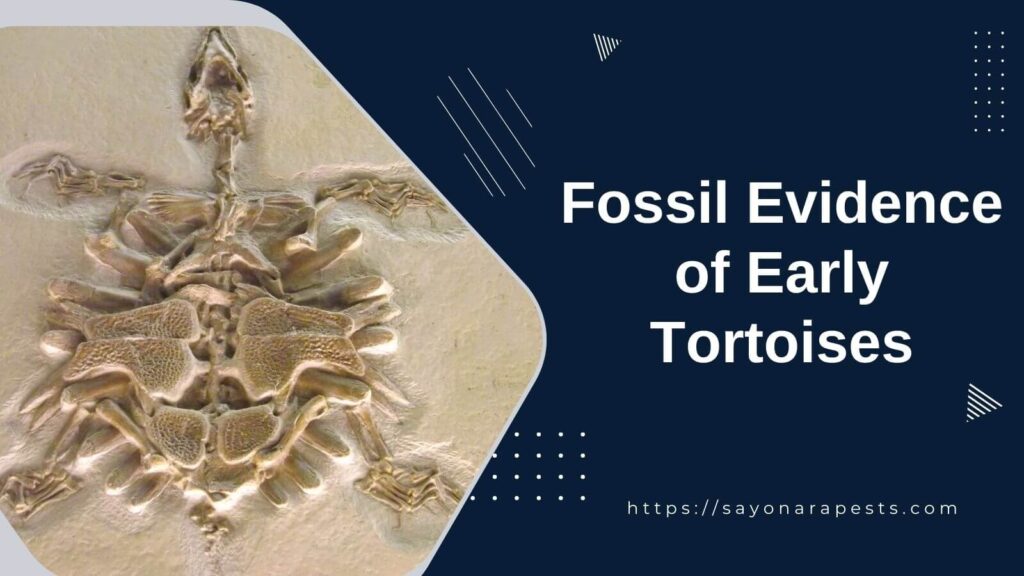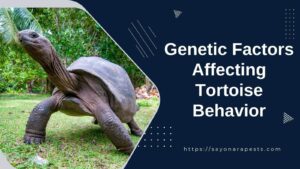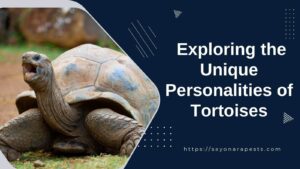Fossil Evidence of Early Tortoises takes you on a fascinating trip through time, where the mysterious origins of these ancient animals are hidden in the complex layers of Earth’s history. Early tortoise evolution is a fascinating puzzle that goes back millions of years.
It catches the attention of both scientists and fans and makes them want to learn more about the past. With fossils as their map, scientists set out on a never-ending quest to hear the whispers of time and figure out what these tough reptiles’ footprints mean.
In a place where imagination and scientific rigor meet, the importance of fossil evidence rings loud and clear. Fossils are the physical keys to the vast treasury of information about how tortoises have changed over time.
By carefully putting these fossilized pieces together, scientists shed light on the complicated tapestry of life’s evolution. This has changed how we think about the fascinating story of tortoises through the ages.
Get ready for an exciting trip through time, where fossils become ancient storytellers who tell tales of survival, change, and the amazing journey of early tortoises.
The Earliest Tortoises
The study of the oldest tortoises tells us a lot about how these interesting reptiles have changed and evolved over time. Fossils from millions of years ago show how far tortoises have come and where they came from in the past.
The oldest known fossils of tortoises have been found in different parts of the world, giving scientists important information about how they lived in the past.
The oldest fossils of tortoises found in North America are an important find in the field of paleontology. The western parts of the United States are where these fossils, which are thought to be about 40 million years old, were found.
In particular, they were found in old sedimentary rock formations, giving us a look into the past. This important discovery shows that tortoises as a species are strong and can live for a long time.
The way these early tortoises looked gives us important information about how they changed over time. These ancient reptiles had a few key features that have stayed mostly the same over the course of their evolution.
For example, the first tortoises had a shell made of bony plates called “scutes,” which gave them protection and helped them stay together.
Also, their bodies were made for life on land. They had strong legs and hard shells that helped them get around in different places.
By looking at these early tortoise fossils, scientists have been able to learn a lot about how these animals have changed over time. The fact that these ancient tortoises can be found in different parts of the world suggests that they evolved on more than one continent.
The fossil record shows that tortoises probably all came from the same ancestor and changed over time to live in different places. These early fossils also show how tortoise traits, like their unique shell structure and specialized limb anatomy, changed and improved over time.
The study of the first tortoises is very important to our understanding of the larger patterns of evolution that have shaped the diversity of life on Earth.
By putting together the pieces of the puzzle of these ancient animals, scientists can trace the complicated paths of evolution and learn about the environmental factors that affected how they grew and changed.
The discovery and study of fossils of early tortoises show how important paleontological research is for learning about the past of our planet.
The oldest fossils of tortoises that have been found around the world give us a glimpse into the distant past. They show us where these amazing reptiles came from and how they have changed over time.
Finding these fossils in different places, like North America, and figuring out their most important physical traits tell us a lot about how tortoises evolved in the past.
Scientists have put together a fascinating story of how these ancient creatures changed over time by carefully analyzing and interpreting the evidence.
The study of these early tortoises not only helps us learn more about their own history but also helps us learn more about the natural history of the Earth as a whole.
Evolution of Tortoiseshell
The tortoise’s shell is a fascinating example of how complex natural selection and adaptation can be. Over millions of years, these amazing reptiles have gone through a lot of changes, which led to the development of the shell that makes tortoises stand out.
When you look at how the tortoiseshell has changed over time, you can learn a lot about the biological and environmental factors that have shaped these animals over time.
About 200 million years ago, at the end of the Triassic period, the first ancestors of modern tortoises appeared. The carapace of these early turtles was like a shell. It was made of bone plates and ribs that were fused together.
The shells of these early reptiles didn’t have the characteristic dome shape like the shells of modern tortoises. Instead, it had a shape that was flatter and longer, which made it easier to move around.
As tortoises kept changing, they adapted to different ecological niches and made big changes to the way their shells are made. The carapace became deeper and more dome-shaped, which was a big change.
Tortoises got many benefits from this change in their evolution. The dome shape gave them more protection from predators and made it possible for them to hide their heads, limbs, and tail inside the shell.
Also, the shell’s convex shape helped spread out the weight, making it easier to move on land and stay afloat in water.
The plastron, the part of the shell that covers the tortoise’s belly, was another important change in the shell’s history. Early tortoises had a plastron made of a series of bone plates that were not completely joined to the carapace.
But as tortoises got used to living in different places, their plastron changed to better protect and support them. In modern tortoises, the plastron is completely joined to the carapace. This makes a solid, impenetrable shield that protects the organs that keep the animal alive.
The evolution of the tortoiseshell shows how genetic mutations, natural selection, and environmental pressures work together in a complex way. As tortoises became more different and moved to different places, their shells changed to meet their specific needs.
The shape, size, and structure of the shell changed over time because of predators, the climate, the type of habitat, and even what the animal ate.
Natural selection favored tortoises with bigger, stronger shells in places where they were likely to be eaten. Because the shell offered more protection, these creatures were able to live and have babies, passing on their good qualities to the next generation.
In the same way, tortoises that lived in areas with little water and high temperatures made changes to their shells to help them survive.
Some of these changes were thicker shells with less surface area to prevent water loss and changes to the scutes that made them better at reflecting heat.
The development of the tortoise’s body is also tied to how its shell has changed over time. As tortoises evolved, their shells became more and more connected to their bones. This gives their organs and muscles support and places to hold on to.
For example, the ribs fused to the shell, making a strong framework that keeps the bird stable and protects it. The shell also gives the muscles a place to attach, so tortoises can move their limbs and pull themselves back into their shells.
In the end, the fact that the tortoiseshell has changed over time shows how well these ancient reptiles have been able to adapt.
From their earliest ancestors, which had flat, long shells called carapaces, to modern tortoises, which have dome-shaped, strong shells, the tortoiseshell has changed a lot over millions of years.
The shape, structure, and materials of the shell have changed over time because of ecological factors, pressures from predators, and the different places where tortoises have lived and thrived.
When you look at how the tortoiseshell has changed over time, you can learn a lot about the complicated processes that have led to the variety and survival strategies of these fascinating animals.
Early Tortoise Diversity
Through fossils, scientists have learned a lot about the world of early tortoises, which was a very interesting place. Finding and studying different kinds of early tortoises has shown how diverse this group was in the past.
These early tortoises have different body parts and adaptations to their environments. This gives us important information about how they evolved and what factors shaped their development.
The Meiolaniidae family, which lived during the late Cretaceous and early Tertiary periods, was one of the first types of tortoises found in fossils. Some species of these tortoises could grow to be up to three meters long, which was a very large size.
The Meiolaniidae family also had something unusual: their shells were made of bone and had spikes or horns sticking out of them. These traits set them apart from modern tortoises and may have helped them protect themselves from possible predators.
The Testudinidae family of early tortoises appeared during the Paleocene time period. The Testudinidae were different from the Meiolaniidae in that their shells were more like those of tortoises today.
But the early Testudinidae tortoises were different in size and shell shape, which shows that they adapted to different environments in different ways.
Some species had longer necks and limbs, which showed that they liked living on land, while others had shorter limbs and a domed shell, which showed that they liked living in places with lots of water.
The different kinds of early tortoises tell us a lot about how tortoises have changed over time.
The fact that tortoises have so many different looks and adaptations suggests that they have gone through a complicated process of evolution, branching off into different lineages that did well in different ecological niches.
Meiolaniidae tortoises have spikes on their shells, which is a unique trait. This suggests that early tortoises developed specific defenses to deal with their environment and possible threats.
Also, the fact that early tortoises had different shell shapes and leg shapes shows that they adapted to different environments and ways of life. Some tortoises probably lived in dry, land environments, while others liked to live in water or near water.
These changes show how ecologically flexible and tough early tortoises were, allowing them to live in many different places around the world.
Studying the early diversity of tortoises not only tells us more about how they evolved but also helps us understand the bigger ideas of biodiversity and adaptive radiations.
The different traits and environmental adaptations of these ancient tortoises show how genetic variation, environmental factors, and evolutionary pressures work together.
Understanding how early tortoises changed over time helps us understand the complicated forces that have led to the wide variety of life on Earth.
In this regard, fossil evidence of early tortoise diversity has shown a fascinating range of shapes, sizes, and ways of living. The Meiolaniidae and Testudinidae families are two well-known examples of early tortoises.
Each family has its own physical traits and preferences for living in different environments. By looking at these ancient tortoises, scientists can learn a lot about how evolution has changed tortoises today and what this means for our understanding of biodiversity and adaptive radiations.
Tortoise Ancestors
You can find the ancestors of modern tortoises in a fascinating line of ancient animals that lived on Earth millions of years ago. Even though scientists still don’t know for sure where tortoises came from, they have come up with some interesting ideas about how they evolved.
The search for tortoise ancestors has been helped by fossil discoveries, genetic studies, and studies that compare the anatomy of different tortoises.
One theory says that the ancestors of tortoises lived during the late Permian and early Triassic periods when the first groups of reptiles appeared. This theory says that tortoises and other reptilian species, like lizards and snakes, all share a common ancestor.
People who support this idea say that tortoises and these groups of reptiles have similar skeletons and ways of reproducing. Critics, on the other hand, say that these similarities could be the result of convergent evolution rather than a direct relationship between the two species.
Another idea is that tortoises are related to a group of reptiles called the procolophonoids, which lived a long time ago. During the Permian and Triassic times, there were small reptiles that looked like lizards and were called procolophonoids.
Fossils show that some procolophonoids had structures on their backs that looked like shells, like the shells that protect tortoises today. Some scientists think that tortoises came from a certain lineage of procolophonoids because of this interesting similarity.
But this theory has been criticized by other scientists who say that the structures in procolophonoids that look like shells are not the same as the shells of tortoises.
In the past few years, genetic studies have helped us learn more about how tortoises evolved. In one of these studies, the DNA of different species of tortoises was looked at. The results showed that tortoises are closely related to a group of reptiles called archosaurs.
Archosaurs include both crocodiles and birds, which could point to a connection between two groups that seem to be very different.
Because of these findings, more research is being done on how tortoises and archosaurs are related in terms of evolution. This gives us a new look at the possible ancestors of tortoises.
Understanding the ancestors of tortoises isn’t just interesting from an evolutionary point of view; it’s also important for understanding the history of evolution for the whole group.
By figuring out the tortoise family tree, scientists can learn about the unique adaptations and physical changes that have happened over the course of their evolution. Knowing about tortoises’ ancestors can also tell us a lot about where they live and how they move around.
Also, knowing how tortoises evolved can help scientists predict and lessen the effects that changes in the environment might have on these species in the future.
In the end, the search for the ancestors of modern tortoises has been an interesting scientific quest. Several ideas have been put forward, but the exact lineage is still being researched and debated.
Paleontological discoveries, genetic studies, and comparisons of body parts have all helped us learn more about how tortoises have changed over time.
The search for tortoise ancestors not only satisfies our interest in the past but also helps us learn more about how these unique animals have adapted and how they have changed over time.
Significance of Fossil Evidence
Fossil evidence is a key part of our understanding of how tortoises evolved in the past. It shows us where these fascinating reptiles came from and how they changed over time. Fossils are like windows into the past.
They help scientists figure out how extinct tortoise species looked, behaved, and interacted with their environment. Researchers can put together the puzzle of tortoise evolution by studying fossils.
They can do this by following the tortoise’s lineage back through time and finding key points in their development.
When it comes to tortoise evolution, fossils are important because they show that tortoises existed in the past and allow us to figure out what their ancestors looked like.
Fossils keep important parts of the body, like the structure of the shell, the shape of the limbs, and the shape of the head, which are needed to understand how animals changed over millions of years.
By looking at these fossils, scientists can find the key characteristics that define each lineage of tortoises, find transitional forms, and figure out how different species evolved.
Technology changes have changed the field of tortoise paleontology, making it easier to read and understand fossil evidence.
High-resolution imaging techniques, like computed tomography (CT) scanning and synchrotron imaging, let scientists look at fossils in more detail than ever before without damaging them.
These imaging methods can reconstruct internal structures in three dimensions, showing intricate parts of the body that were not visible before.
Scientists can learn a lot about the functional anatomy and biomechanics of ancient tortoises by digitally dissecting and visualizing their fossilized remains. This gives us a better understanding of how they adapted over time.
Also, molecular biology and genetics have made progress, which has helped traditional paleontology.
By taking ancient DNA from fossils of well-preserved tortoises and analyzing it, scientists can figure out how tortoises were related genetically, track how they changed over time at the molecular level, and learn about the population dynamics and migration patterns of ancient tortoise species.
This multidisciplinary approach, which uses both paleontological and molecular techniques, has helped us learn a lot about how tortoises have changed over time and how complex processes have led to their variety.
The study of fossils could lead to a lot of new discoveries in the field of tortoise evolution in the future. As new fossils are found and old ones are looked at again with more advanced methods, we can expect to learn more about the early stages of tortoise evolution.
Fossils from places that haven’t been looked at before or from times when there aren’t many fossils could tell us exciting new things about how ancient tortoise lineages changed, where they lived, and how they interacted with their environment.
Researchers will be able to get even more information from fossils as they continue to improve analytical methods like geometric morphometrics, stable isotope analysis, and ancient proteomics.
These methods can give us more information about how tortoises have changed over time, including what they eat, where they like to live, how they move, and how their bodies have changed.
In short, fossil evidence is the most important thing we can use to learn more about how tortoises have changed over time.
Scientists can figure out how tortoises have changed over millions of years by looking at fossils, using new technology, and taking an interdisciplinary approach.
They can also reconstruct ancestral forms, trace evolutionary lines, and figure out the complicated processes that have shaped tortoises. In the future, scientists hope to find out more about these ancient reptiles and learn more about their amazing journey through evolution.
In conclusion, studying fossils of early tortoises gives us important information about how these interesting animals have changed over time. Scientists have been able to figure out where tortoises came from by looking at the oldest fossils of them.
This has given them important information about their physical features and diversity. From its earliest form to how it looks now, the evolution of the tortoiseshell shows how tortoises have changed over millions of years.
By finding fossils of different kinds of early tortoises, scientists have been able to learn more about how these ancient reptiles looked and how they adapted to their environment.
By looking at these differences, scientists have been able to get a better idea of how tortoises have changed over time and how different species have adapted to different environments and ways of life.
Finding out who the possible ancestors of modern tortoises might be has been the subject of a lot of research. Many hypotheses have been put forward and supported by evidence.
The study of tortoise ancestors gives us important information about how the group has changed over time and helps us figure out the complicated web of evolution.
Scientists can figure out where tortoises came from and how they changed over time by looking at the fossil record and analyzing the shapes of ancient reptiles.
We know a lot about how tortoises have changed over time because of fossils. New imaging techniques, like high-resolution CT scanning and three-dimensional modeling, have made it much easier to figure out what fossils of tortoises mean and get useful information from them.
Researchers have been able to find new information and learn more about how tortoises have changed because of these advances.
The study of fossils shows that there is still a lot to learn about how tortoises have changed over time. Continued research in this field could lead to the discovery of new species and fill in gaps in our understanding of how tortoises have changed over time.
Also, improvements in analytical methods and collaborations between different fields may give us more information about the genetic and ecological aspects of tortoise evolution, which would add to what we know from the fossil record.
In a nutshell, studying the fossils of early tortoises gives us a fascinating look at how these amazing animals have changed over time.
Scientists have learned more about tortoise evolution by looking at the earliest fossils of tortoises, how their shells changed over time, how different early tortoises were, and what might have been their ancestors.
Fossil evidence is still a big part of how we learn more about this topic, and more research will likely lead to exciting discoveries that will help us learn more about how tortoises have changed over time and how life on Earth has changed in general.




